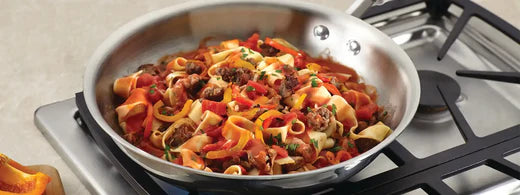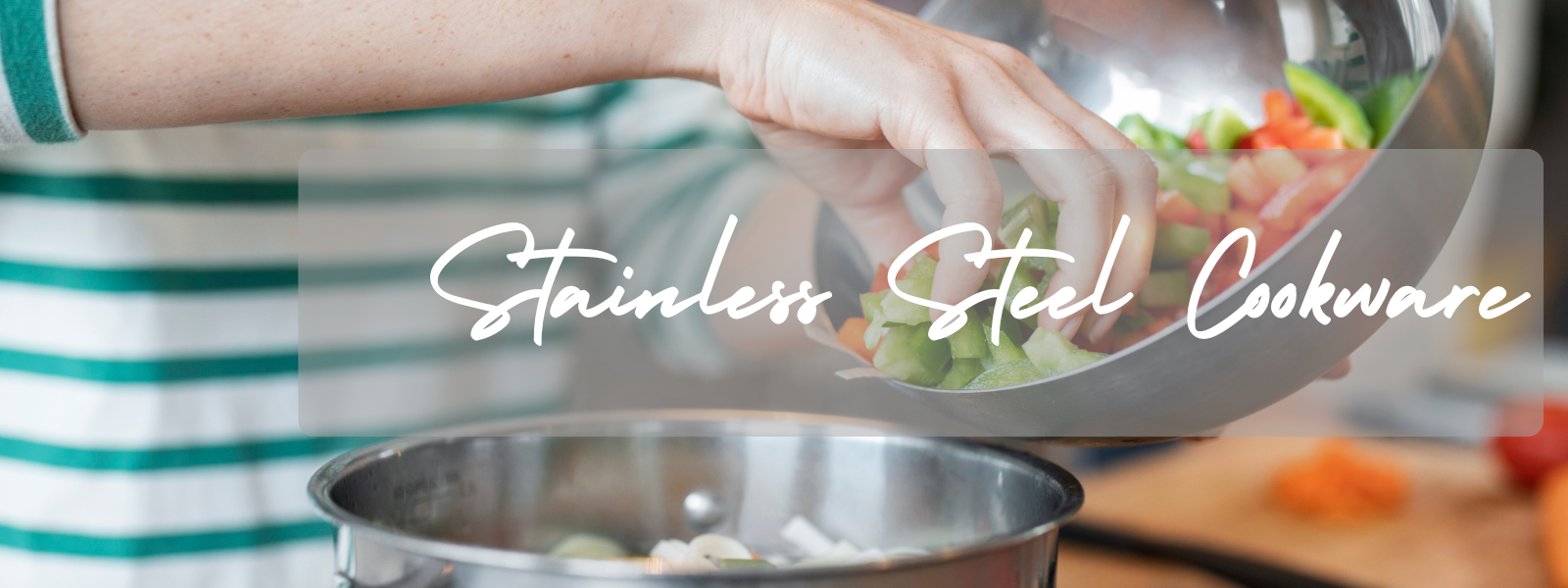Stainless steel has been a trusted companion in Indian kitchens for decades. Despite the rise of nonstick pans, cast iron revival, and modern ceramic cookware, stainless steel remains the most preferred material for everyday cooking in India. From dal and sabzi to frying, boiling, and steaming, it handles it all with unmatched reliability.
But what makes stainless steel such a timeless favourite? Why does it continue to dominate Indian households even today? Here is a complete, in-depth look at what makes stainless steel cookware irreplaceable in India.
Table of Contents
- 1. Stainless Steel Is Durable Enough to Last for Generations
- 2. Completely Safe and Non-Reactive — Perfect for Indian Ingredients
- 3. Versatility: One Material, Endless Indian Dishes
- 4. Even Heating and Fast Cooking with Tri-Ply or Sandwich Base Designs
- 5. Low Maintenance Compared to Other Cookware Materials
- 6. Hygienic and Odour-Free: Ideal for Multi-Dish Indian Kitchens
- 7. Works on All Cooktops — Gas, Induction, Electric
- 8. Economical in the Long Run — True Value for Money
- 9. Conclusion
Stainless Steel Is Durable Enough to Last for Generations
Indian cooking often involves high heat, repeated boiling, long simmering, and frequent frying. Stainless steel is one of the few cookware materials that can withstand all of this without damage.
Why Durability Matters in India
- Most households cook multiple meals daily.
- Utensils face heavy use, washing, and heat shock.
- Many families prefer cookware they can pass down to the next generation.
High-quality options like Meyer Select Nickel-Free Stainless Steel Cookware or Meyer Trivantage Stainless Steel come with thick bases and sturdy construction, ensuring they last for years while resisting dents, warping, and rust.
Completely Safe and Non-Reactive — Perfect for Indian Ingredients
Indian food uses acidic ingredients such as tomatoes, tamarind, vinegar, curd, and lemon. Stainless steel stays non-reactive with all of these.
Why Safety Is a Big Plus
-
No metallic taste in food
-
No leaching of harmful materials
-
Suitable for boiling milk, preparing curd, and storing leftovers
Nickel-free stainless steel—offered by Meyer—is especially popular for families seeking toxin-free cooking solutions.
Versatility: One Material, Endless Indian Dishes
India’s cooking methods are diverse—tadka, simmering, boiling, sautéing, bhuna, steaming, slow-cooking, and frying. Stainless steel adapts beautifully to all.
Perfect For
- Dal, khichdi, pulao
- Curries and gravies
- Rasam, sambar, soups
- Sabzis, stir-fries
- Steaming idlis or vegetables
- Deep frying pakoras, puris, vadas
With products like the Meyer Stainless Steel Multi-Pot or the Meyer Accent Sauté Pan, home cooks can prepare everything from breakfast to dinner without switching pans constantly.
Meyer Select Stainless Steel Sauteuse 28cm
Even Heating and Fast Cooking with Tri-Ply or Sandwich Base Designs
Traditional low-grade steel used to have hot spots, but modern stainless steel cookware (especially tri-ply) eliminates this problem.
Benefits of Tri-Ply Stainless Steel
- Heats quickly
- Distributes heat evenly
- Prevents burning and sticking
- Improves overall cooking efficiency
Meyer’s Tri-Ply Stainless Steel Cookware, built with an aluminium core sandwiched between two layers of steel, ensures professional-level heat distribution—ideal for Indian dishes that require slow and steady cooking.
Low Maintenance Compared to Other Cookware Materials
Indian households appreciate cookware that’s easy to clean and doesn’t require special care.
Stainless Steel Wins Because It’s
- Dishwasher-safe
- Rust-resistant
- Easy to scrub
- Safe to use with metal spoons
- Non-porous and stain-resistant
Unlike cast iron, it doesn’t need seasoning. Unlike nonstick pans, it doesn’t need gentle handling. Stainless steel fits perfectly into fast-paced kitchens.
Hygienic and Odour-Free: Ideal for Multi-Dish Indian Kitchens
Indian kitchens often cook multiple dishes back-to-back. Stainless steel does not absorb flavours, colours, or aromas.
This Means
-
You can cook fish today and kheer tomorrow in the same pot.
-
It stays fresh and odour-free for years.
-
No cross-contamination of tastes.
This hygiene factor makes stainless steel the most trustworthy material for boiling, storing, reheating, and meal prep.
Works on All Cooktops — Gas, Induction, Electric
With modern Indian households shifting to induction cooktops, stainless steel continues to remain relevant.
High-Quality Stainless Steel Is
-
Induction-compatible
-
Oven-safe
-
Versatile enough for gas, glass top, and coil stoves
Cookware like the Meyer Accent Stainless Steel Stockpot and Meyer Select Stainless Steel Kadai works seamlessly across all cooktops, making them valuable investments.
Economical in the Long Run — True Value for Money
Stainless steel gives the best return on investment. One good pot or kadai can easily last 10–20 years.
Why It Saves Money
- No coating to peel or replace
- Rarely gets damaged
- Lower maintenance cost
- Suitable for daily use
- One piece can be used for multiple cooking techniques
For families looking for quality without constant replacement, stainless steel remains unbeatable.
Conclusion
Stainless steel cookware remains India’s favourite because it delivers exactly what Indian kitchens need—durability, safety, versatility, and long-lasting performance. From everyday dal to festive biryani, stainless steel adapts to every dish and every household. With modern innovations like nickel-free steel, tri-ply construction, and induction compatibility, today's stainless steel cookware is even more efficient and reliable.
If you're looking to upgrade your kitchen with timeless, high-performance cookware, brands like Meyer offer top-quality options—kadais, saucepans, stockpots, steamers, sauté pans, and more—that combine traditional trust with modern engineering.
A stainless steel pot may look simple, but in an Indian kitchen, it remains the most dependable tool, year after year.













Leave a comment